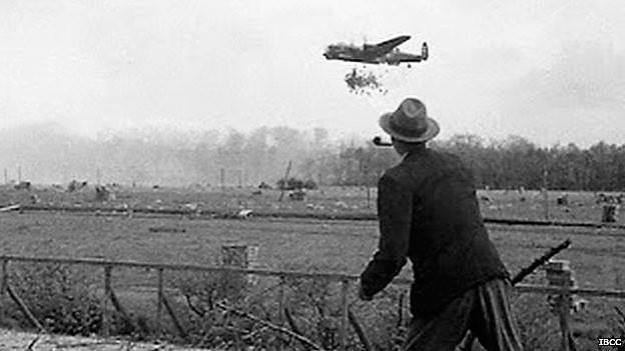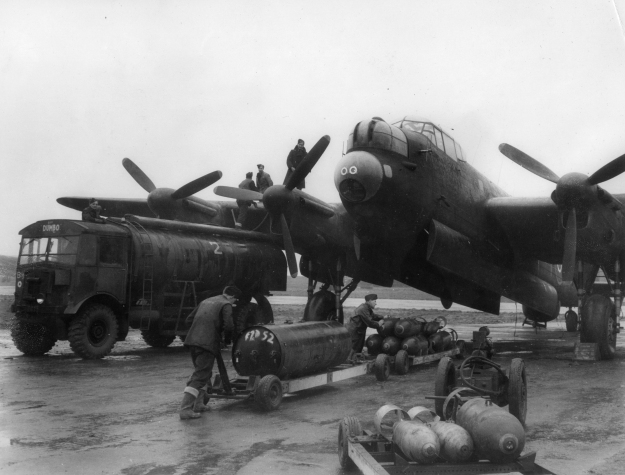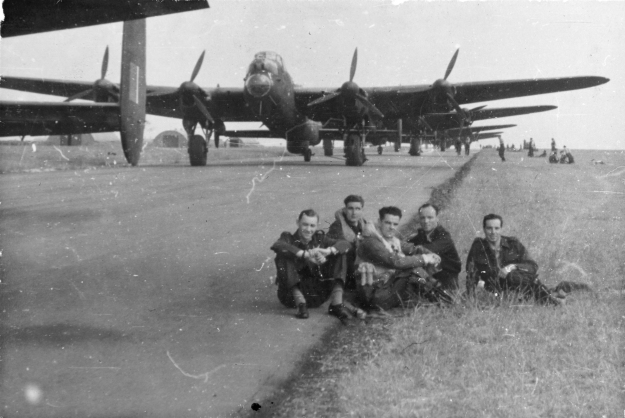One of the most unbelievable bombing missions by the Allies in World War II took place in the closing days of the war, but instead of dropping bombs, the four-engine British Lancaster and American Flying Fortress bombers were dropping rations. After the ambitious, yet failed Operation Market-Garden took place in the Netherlands in September 1944, the Dutch people were stricken with what is referred to as the Hongerwinter or “hunger winter.” The famine, paired with a lack of fuel for warmth, led to an estimated 20,000 civilian deaths. With only half of the country liberated, those in the northern and western portions suffered from continued occupation by German forces, limited food supplies, and the cold season of northwest Europe.
As the war was wrapping up in April of 1945, in an effort to alleviate the suffering of the Dutch, the Allies devised a plan to deliver much needed food via airlift. The plan was complicated for a number of reasons, one of the biggest being the fact that the Germans had their anti-aircraft artillery (AAA) positioned to shoot flak up at the Allied bomber formations on the way to their raids over Nazi Germany. Another was that the Allies and Germans were still at war and the British advance was still pushing forward in the area where many of the rations would need to be dropped.
Negotiations were made for the relief raids with a group of German officers in charge of the occupied Netherlands, with the assistance of Swiss and Swedish emissaries.
One of the key agreements was that certain corridors would be “open,” allowing Allied airmen to fly through, with the promise from the Germans that they would not be fired upon by AAA. This promise, and the fact that the planes would be flying at 400 feet or below (for the safety of the parcels) certainly gave much for the crewmen to be worried about.
The missions went off practically without a hitch. The Germans honored their word, almost entirely, that no coordinated anti-aircraft would fire upon the planes, and countless Dutch civilians benefited from this “manna from heaven.” From April 29 through VE-Day, May 8, 1945, the combined efforts saw over 5,500 sorties dropping over an estimated 10,000 tons of food on the starving and grateful Dutch.
(Additional information from National WII Museum).

Above, Artist Gary Eason’s print of Lancasters dropping food.
Below, A 3 Group Lancaster drops food to awaiting Dutch people.

75 (NZ) Squadron were involved in Operation Manna with 116 aircraft taking part.
29 April 45. Nine aircraft were detailed for Supply Dropping in the Delft area.
30 April 45. Twenty one aircraft were detailed for Supply dropping in the Rotterdam area.
1 May 45. Twenty one aircraft were detailed for Supply Dropping at Delft. The population were very excited. There was a great deal of flag waving and thanks messages were seen painted on the roof tops.
2 May 45. Twenty one aircraft were detailed for Supply Dropping at Delft. The crowd were not as large as usual, but more flags were observed. F/O E. Ohlson reported having seen Germans in barracks cheering and waving white flags. F/O R. Flamank saw Germans waving from gun-posts on the coast.
4 May 45. Six aircraft were detailed for Supply Dropping. Three for the Hague, and three for Delft.
5 May 45. Four aircraft were detailed for Supply Dropping at the Hague.
7 May 45. Twenty six aircraft were detailed for Supply Dropping at Delft.
8 May 1945. (V.E. Day). Eight aircraft were detailed for Supply Dropping at Rotterdam.




![ALB2318313017 Image from the Allan Mason Forbes Alexander personal album. AMF Alexander and his No. 75 Squadron crew beside the port main wheel of their Stirling. Unknown location in England. Handwritten under the print "Operations crew 1943 75 NZ. Squadron. England. / [L-R] McDonald Rear Gunner, Des Andersen Navigator, Frank Howard Engineer, Doc Lyon Mid Upper Gunner, Tom Mayhew Wireless Operator, Phil Pullyn Bomb Aimer. A Alexander Pilot [crouching in front]."](https://i0.wp.com/75nzsquadronremembered.wordpress.com/wp-content/uploads/2024/02/alb2318313017.jpg?w=339&h=253&ssl=1)
![ALB933373021 Image from the R. W. Russell personal album collection. No. 75 Squadron Lancaster crew in front of a Nissen (Quonset) hut. Believed to be at RAF Station Mepal. L-R: "Jack, Ivor, myself [R.W. Russell], George, Fred (crouching, front), Nev, Vic".](https://i0.wp.com/75nzsquadronremembered.wordpress.com/wp-content/uploads/2024/02/alb933373021.jpg?w=339&h=226&ssl=1)




![ALB933374039 Image from the RW Russell personal album collection. "Bruce's Crew. [L-R] Rear Gunner "Tutty", Navigator Jeff Boulton, Bomb Aimer Cyril Bullock, Pilot Bruce, Wireless Operator "Scotty", Flight Engineer Bill Allred, Mid Upper Gunner "Smithy". Presumed to be No. 75 Squadron personnel.](https://i0.wp.com/75nzsquadronremembered.wordpress.com/wp-content/uploads/2024/02/alb933374039.jpg?w=249&h=175&ssl=1)











